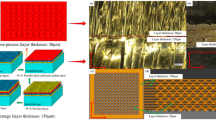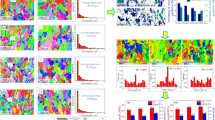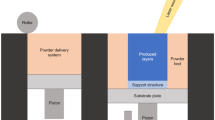Abstract
The powder bed fusion (PBF) process using Ti–6Al–4V powder has the specific application in additive manufacturing of a high-performance structural parts in the aerospace and medical industries. The PBF involves the repeated accumulation of laser melted layers. Consequently, high anisotropic residual stresses and local temperature accumulation occur during the rapid melting and cooling in the process. These factors affect the mechanical properties of the as-built structure. In particular, we revealed the effective interval island laser-scanning strategy with less grain size, thermal effect and anisotropic residual stresses of the additively manufactured structure, compared to those of the strip and continuous laser-scanning strategies. Through the cantilever experiment, it was confirmed that the interval island laser-scanning strategy reduced deformation by up to 7.7% compared to that of the conventional strip laser-scanning strategy due to the reduction of anisotropic residual stresses.










Similar content being viewed by others
References
Thompson, S. M., Bian, L., Shamsaei, N., et al. (2015). An overview of Direct Laser Deposition for additive manufacturing; Part I: Transport phenomena, modeling and diagnostics. Additive Manufacturing, 8, 36–62.
Lee, H. J., Song, J. G., & Ahn, D. G. (2017). Investigation into the influence of feeding parameters on the formation of the fed-powder layer in a powder bed fusion (PBF) system. International Journal of Precision Engineering and Manufacturing, 18, 613–621.
Kahhal, P., Jo, Y. K., & Park, S. H. (2023). Recent progress in remanufacturing technologies using metal additive manufacturing processes and surface treatment. International Journal of Precision Engineering and Manufacturing-Green Technology. https://doi.org/10.1007/s40684-023-00551-2
Jin, Q. Y., Yu, J. H., Ha, K. S., et al. (2021). Multi-dimensional lattices design for ultrahigh specific strength metallic structure in additive manufacturing. Materials and Design, 201, 109479.
Wesley, R. J., Park, S. J., & Moon, S. K. (2023). A design optimization framework for 3D printed lattice structures. International Journal of Precision Engineering and Manufacturing–Smart Technology, 1(2), 145–156.
Kang, D., Park, S. H., Son, Y., et al. (2019). Multi-lattice inner structures for high-strength and light-weight in metal selective laser melting process. Materials and Design, 175, 107786.
Roehling, J. D., Smith, W. L., Roehling, T. T., et al. (2019). Reducing residual stress by selective large-area diode surface heating during laser powder bed fusion additive manufacturing. Additive Manufacturing, 28, 228–235.
Park, S. H., Choi, S., & Jhang, K. Y. (2021). Porosity evaluation of additively manufactured components using deep learning-based ultrasonic nondestructive testing. International Journal of Precision Engineering and Manufacturing-Green Technology. https://doi.org/10.1007/s40684-021-00319-6
Sun, L., Ren, X., He, J., et al. (2021). Melting cell based compensated design method for improving dimensional accuracy of additively manufactured thin channels. International Journal of Precision Engineering and Manufacturing-Green Technology. https://doi.org/10.1007/s40684-020-00299-z
Srivastava, S., Garg, R. K., Sharma, V. S., et al. (2020). Multi-physics continuum modelling approaches for metal powder additive manufacturing: A review. Rapid Prototyping Journal, 26(4), 737–764.
Withers, P. J., & Bhadeshia, H. (2001). Residual stress. Part 2–Nature and origins. Journal of Materials Science & Technology, 17(4), 366–375.
Levkulich, N., Semiatin, S., Gockel, J., et al. (2019). The effect of process parameters on residual stress evolution and distortion in the laser powder bed fusion of Ti-6Al-4V. Additive Manufacturing, 28, 475–484.
Wang, J., Zhu, Y., Li, H., et al. (2022). Numerical study of the flow field and spatter particles in laser-based powder bed fusion manufacturing. International Journal of Precision Engineering and Manufacturing-Green Technology, 9(4), 1009–1020.
Martucci, A., Aversa, A., Bondioli, F., et al. (2022). Synergic strategies to improve the PBF-LBM processability of a cracking-sensitive alloy. Materials and Design, 224, 111396.
Fang, Z. C., Wu, Z. L., Huang, C. G., et al. (2020). Review on residual stress in selective laser melting additive manufacturing of alloy parts. Optics & Laser Technology, 129, 106283.
Singh, D. D., Mahender, T., et al. (2021). Powder bed fusion process: A brief review. Materials Today: Proceedings, 46, 350–355.
Liu, S., & Shin, Y. C. (2019). Additive manufacturing of Ti6Al4V alloy: A review. Materials and Design, 164, 107552.
Lee, J. H., Park, S. J., Yang, J., et al. (2022). Crack guidance utilizing the orientation of additive manufactured lattice structure. International Journal of Precision Engineering and Manufacturing, 23(7), 797–805.
Wei, H. L., Mukherjee, T., Zhang, W., et al. (2021). Mechanistic models for additive manufacturing of metallic components. Progress in Materials Science, 116, 100703.
Chowdhury, S., Yadaiah, N., Prakash, C., et al. (2022). Laser powder bed fusion: A state-of-the-art review of the technology, materials, properties & defects, and numerical modelling. Journal of Materials Research and Technology, 20, 2109–2172.
Gordon, J. V., Haden, C. V., Nied, H. F., et al. (2018). Fatigue crack growth anisotropy, texture and residual stress in austenitic steel made by wire and arc additive manufacturing. Materials Science and Engineering A, 724, 431–438.
Strantza, M., Ganeriwala, R. K., Clausen, B., et al. (2021). Effect of the scanning strategy on the formation of residual stresses in additively manufactured Ti-6Al-4V. Additive Manufacturing, 45, 102003.
Guan, K., Wang, Z., Gao, M., et al. (2013). Effects of processing parameters on tensile properties of selective laser melted 304 stainless steel. Materials and Design, 50, 581–586.
Monu, M. C., Afkham, Y., Chekotu, J. C., et al. (2023). Bi-directional scan pattern effects on residual stresses and distortion in as-built nitinol parts: A trend analysis simulation study. Integrating Materials and Manufacturing Innovation, 12(1), 52–69.
Chen, Q., Taylor, H., Takezawa, A., et al. (2021). Island scanning pattern optimization for residual deformation mitigation in laser powder bed fusion via sequential inherent strain method and sensitivity analysis. Additive Manufacturing, 46, 102116.
Ma, Z., Gao, M., Guo, K., et al. (2023). Analysis and optimization of energy consumption for multi-part printing using selective laser melting and considering the support structure. International Journal of Precision Engineering and Manufacturing-Green Technology, 10(3), 693–707.
Javidrad, H. R., & Salemi, S. (2020). Effect of the volume energy density and heat treatment on the defect, microstructure, and hardness of L-PBF Inconel 625. Metallurgical and Materials Transactions A: Physical Metallurgy and Materials Science, 51(11), 5880–5891.
Goel, S., Neikter, M., Capek, J., et al. (2020). Residual stress determination by neutron diffraction in powder bed fusion-built Alloy 718: Influence of process parameters and post-treatment. Materials and Design, 195, 109045.
Yang, J., Park, S. J., Kim, S. H., et al. (2023). Effective spiral laser path for minimizing local heating and anisotropic microstructures in powder bed fusion additive manufacturing. 3D Printing and Additive Manufacturing. https://doi.org/10.1089/3dp.2023.0065
Nadammal, N., Mishurova, T., Fritsch, T., et al. (2020). Critical role of scan strategies on the development of microstructure, texture, and residual stresses during laser powder bed fusion additive manufacturing. Additive Manufacturing, 38, 101792.
Liu, J., Li, G., Sun, Q., et al. (2022). Understanding the effect of scanning strategies on the microstructure and crystallographic texture of Ti–6Al–4V alloy manufactured by laser powder bed fusion. Journal of Materials Processing Technology, 299, 117366.
Rivalta, F., Ceschini, L., Jarfors, A. E., et al. (2021). Effect of scanning strategy in the L-PBF process of 18Ni300 maraging steel. Metals, 11(5), 826.
Valente, E. H., Gundlach, C., Christiansen, T. L., et al. (2019). Effect of scanning strategy during selective laser melting on surface topography, porosity, and microstructure of additively manufactured Ti–6Al–4V. Applied Sciences, 9(24), 5554.
Mugwagwa, L., Dimitrov, D., Matope, S., et al. (2019). Evaluation of the impact of scanning strategies on residual stresses in selective laser melting. International Journal of Advanced Manufacturing Technology, 102, 2441–2450.
Lu, Y., Wu, S., Gan, Y., et al. (2015). Study on the microstructure, mechanical property and residual stress of SLM Inconel-718 alloy manufactured by differing island scanning strategy. Optics & Laser Technology, 75, 197–206.
Mills, K. C. (2002). Recommended values of thermophysical properties for selected commercial alloys (pp. 211–217). Woodhead Publishing.
FLOW-3D(included laser, DEM module) (2022) Version 12.0.2.5: User Manual, Flow Science, USA.
Ganeriwala, R. K., Strantza, M., King, W., et al. (2019). Evaluation of a thermomechanical model for prediction of residual stress during laser powder bed fusion of Ti–6Al–4V. Additive Manufacturing, 27, 489–502.
Yin, J., Peng, G., Chen, C., et al. (2018). Thermal behavior and grain growth orientation during selective laser melting of Ti–6Al–4V alloy. Journal of Materials Processing Technology, 260, 57–65.
Chen, F., & Yan, W. (2020). High-fidelity modelling of thermal stress for additive manufacturing by linking thermal-fluid and mechanical models. Materials and Design, 196, 109185.
Zhang, H., Li, C., Xu, M., et al. (2021). The fatigue performance evaluation of additively manufactured 304L austenitic stainless steels. Materials Science and Engineering A, 802, 140640.
Wu, L., & Zhang, J. (2018). Phase field simulation of dendritic solidification of ti-6al-4v during additive manufacturing process. Journal of the Minerals, Metals & Materials Society, 70, 2392–2399.
Zhang, J., Song, B., Wei, Q., et al. (2019). A review of selective laser melting of aluminum alloys: Processing, microstructure, property and developing trends. Journal of Materials Science and Technology, 35(2), 270–284.
Acknowledgements
This study was supported by the National Research Foundation of Korea(NRF) grant funded by the Ministry of Education (20021996, Development of DfAM-based 3D Printing technology for combustor parts of private sector initiative small space launcher engine (Weight reduction 20%, integration 50%)) and a Korea Institute of Industrial Technology (KITECH) internal project (JE230014, Development of fabrication technology using DfAM for lightweight and parts consolidation of aviation parts) and the National Research Foundation of Korea (NRF) grant funded by the Korea government (No. 2019R1A5A8083201).
Funding
Ministry of Education (Grant number: 20021996, 2019R1A5A8083201), Korea Institute of Industrial Technology (Grant number: JE230014).
Author information
Authors and Affiliations
Contributions
JY: Conceptualization, methodology, visualization, experiments, investigation, formal analysis, software, writing of original draft, review, and editing. DK: Experiments, formal analysis, investigation. SMY: Methodology, investigation, formal analysis. YS: Conceptualization, supervision, funding, project administration, writing of original draft, review, and editing. SHP: Conceptualization, supervision, funding, project administration, writing of original draft, review, and editing.
Corresponding authors
Ethics declarations
Competing interests
The authors declare that they have no known competing financial interests or personal relationships that could have influenced the research reported in this paper.
Additional information
Publisher's Note
Springer Nature remains neutral with regard to jurisdictional claims in published maps and institutional affiliations.
Rights and permissions
Springer Nature or its licensor (e.g. a society or other partner) holds exclusive rights to this article under a publishing agreement with the author(s) or other rightsholder(s); author self-archiving of the accepted manuscript version of this article is solely governed by the terms of such publishing agreement and applicable law.
About this article
Cite this article
Yang, J., Kang, D., Yeon, S.M. et al. Interval Island Laser-Scanning Strategy of Ti–6Al–4V Part Additively Manufactured for Anisotropic Stress Reduction. Int. J. Precis. Eng. Manuf. 25, 1087–1099 (2024). https://doi.org/10.1007/s12541-024-00967-z
Received:
Revised:
Accepted:
Published:
Issue Date:
DOI: https://doi.org/10.1007/s12541-024-00967-z




